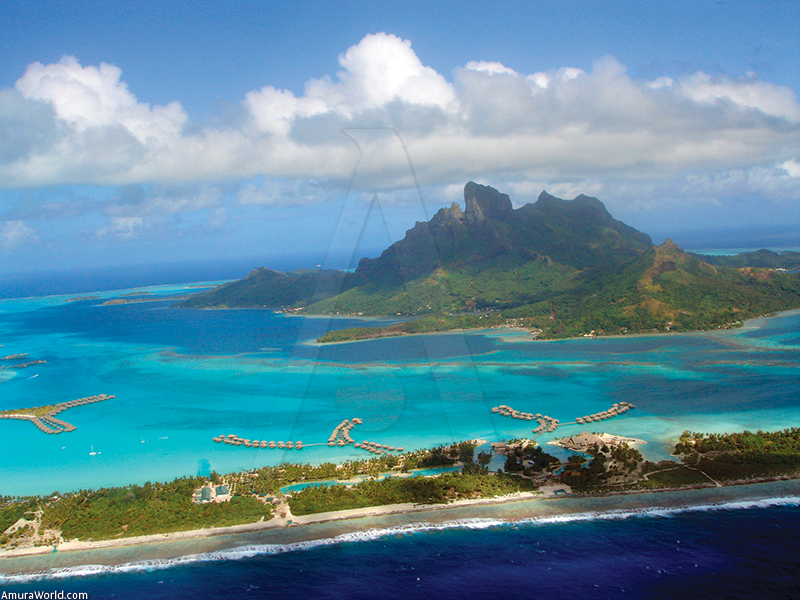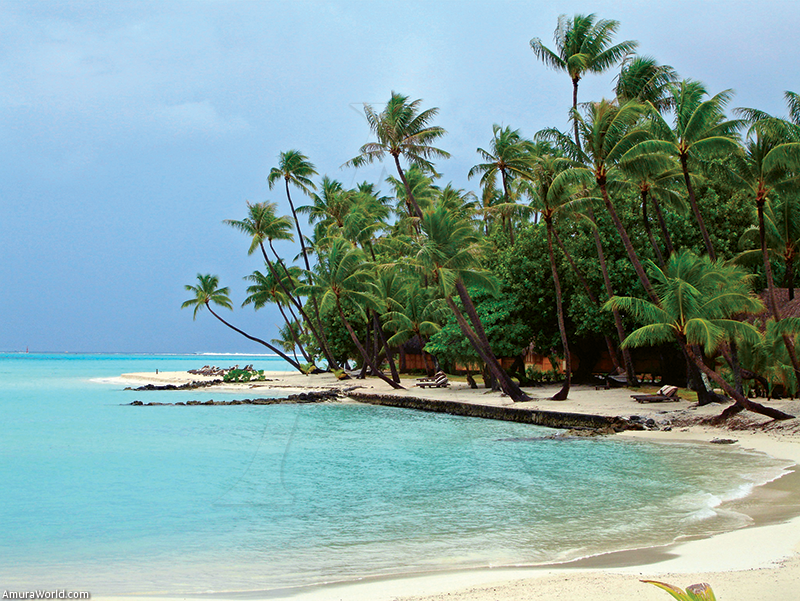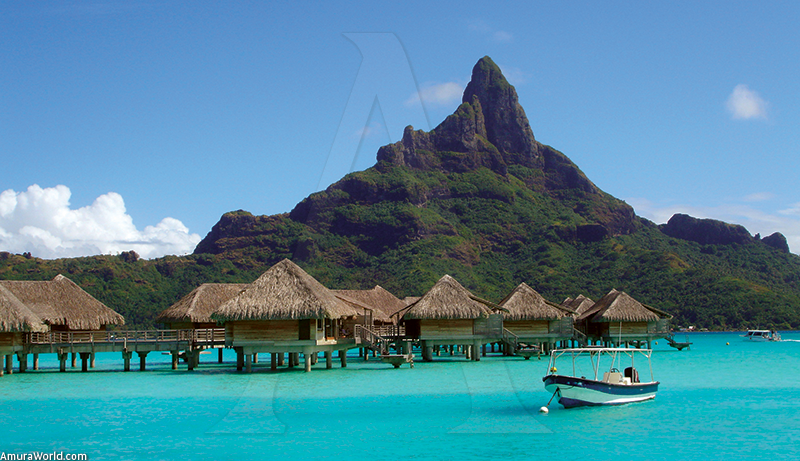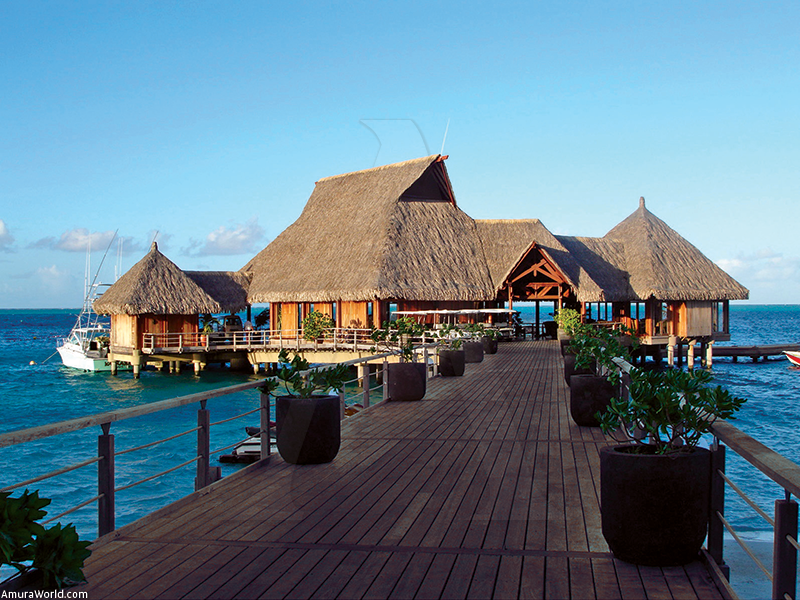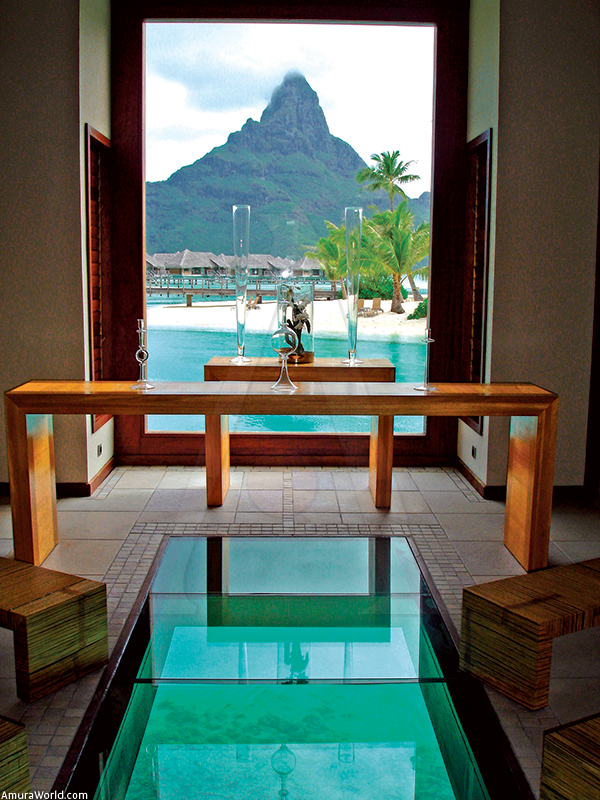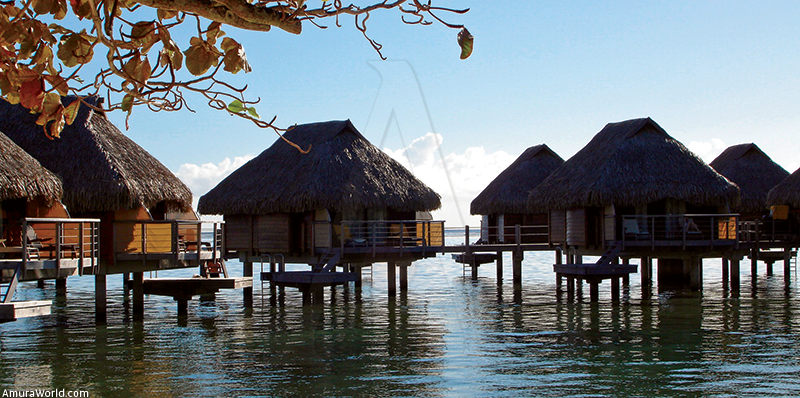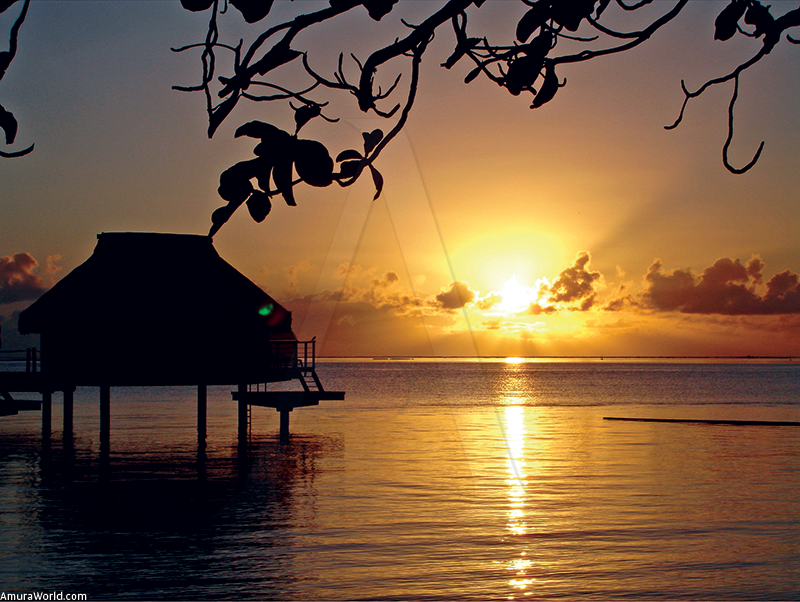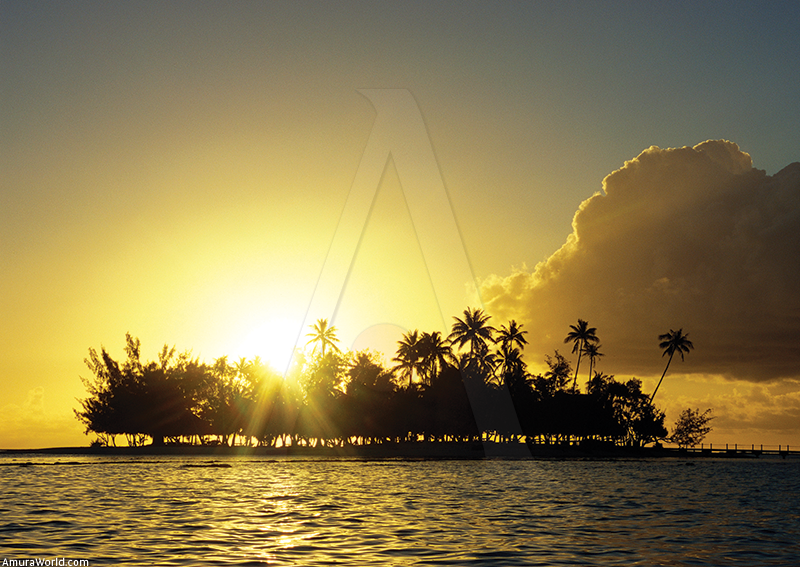The Society Archipelago is divided in two parts, the Windward Islands formed by four grand islands, including Tahiti (which in turn is divided in two islands: Tahiti Nui, the biggest, and Tahiti Iti, which is the smallest), Moorea and Etiaora and on the other hand, the Leeward Islands. 200 kilometers from Tahiti, that includes Huahine. Bora Bora. Raiatea. Tahaa and Maupiti.
The French Polynesia is formed by five archipelagos with 118 islands extended in an area as big as Europe. The total of the terrestrial surface is just that of the total sum of land of these islands and atolls and is about 4 thousand square kilometers distributed in five archipelagos: Society Islands. Tuamotu Atolls. Marquesas Islands. Austral Islands and Gambier Islands. (The last two lack the hotel infrastructure, only offering small family boarding houses).
Due to their origin they are divided in two kinds of different islands: the upper ones, which emerged from ancient volcanoes, like Tahiti. Moorea. Bora Bora or Huahine. and the lower ones or atolls, like Rangiroa and Manihi. which are easily distinguished by its ring form and its crystal central lagoons. In the first ones mentioned. which are also the bigger ones, spectacular crests can be found, valleys and prairies, surrounded by a coastal lagoon protected by a reef. The second ones are just perfect for the loners and for those who are diving fans.
The Tuamotu Archipelago, east from the Society Archipelago, is the biggest of all. formed by 80 atolls, from which a great part are coralline rings that surround a coralline lagoon. Rangiroa is the largest atoll of this archi- pelago, followed by others like Manihi, Fakarava, Anaa, Kaukura, Taaroa and Tikehau.
The Austral Archipelago consists of five great islands south of Tahiti, separated between them for around 160 and 230 kilometers. These islands with rocky formations are surrounded by coral reefs. The most distant is the Island of Rapa, 1.S00 kilometers from Papeete, in which there are remains of Maoris fortresses in the highest areas of the island. The main town is Mataura, in the island of Tubuai. The Marquesas Islands are located 1500 kilometers northeast from Tahiti and they consist in two groups of volcanic islands, much of them abandoned. The population lives in the volcanic islands of Nuki Hiva, Ua Pou, Ua Huka, Hiva Oa, Tahuata and Fatu Hiva.
The Gambier Islands are extended southeast of the Tuamotu and have around ten small and remote islands barely visited by tourists, which is what makes them almost a paradise. The biggest is Mangareva, with a great elevation of 441 meters and surrounded by a great coral reef.
Bora Bora, refuge for two
There are just a few more romantic places where to escape en couple than a tropical beach. A world of warmth, perfumes and colors is the best scenery for love. And a luxurious hotel helps. Dreams are the matter of what the South Sea Islands are made of, those places that, from imagining them so much, seem not to be real. Until the moment arrives in which the small plane from Tahiti descends, and the sharp peaks of black basalt are distinguished from the vertical walls in dreams. And afterwards you jump into a long boat to traverse the lagoon on the way to the island.
It is difficult to imagine a more romantic arrival to an island than by sea, to cut trough the waters and arrive ashore in a place called Bora Bora. And that’s the way you enter in the kingdom of the senses. The gar- dens burst with the colors and aromas of the bougainvilleas, the gardenias, the hibiscus and the frangipanis. A public road of 32 kilometers surrounds the entire island, and it’s easy to make a half day journey. Taking the side roads you get to the watchtowers from where you can see the island in a bird’s eye view.
But Bora Bora is, above all, sea. Its external lagoon, surrounded by the coral ring, is the most spectacular natural swimming pool of the world. To enjoy it the best thing to do is to hire a one day excursion, in which you go trough different places. The first stop is to feed the sharks and devil fish, but the passengers don't look from the boat, but from inside the water. The sharks aren't that big, but they swallow the pieces of meat in one bite. And a few meters away. Back in the boat the prow is directed to a true coral garden, in which you dive again. That is how you enter into an unimaginable colorful world and you swim between clouds of fishes that look at you the same curious way you look at them. Then the boat makes its way to a motu where there's time to take another bath while food is being prepared. From there, the basaltic milestones of Bora Bora are the best backdrop you can imagine for a beach.
Tahiti
Get close to the highest mountain in the island (2.241meters) and enjoy the views from the Venus Peak, visit the waterfalls in the island, the Paul Gauguin Museum and the Tahiti Museum and its Islands, submerge into the botanical gardens and/or the public parks, where you can find one of the waterfalls in the island. Explore the Marae of Arahurahu, in the valley of Paea, sacred ancient place where a lot of islanders kings were crowned, to finish in Mara’ a Grottos.
Papeete has a market where you can find handicraft objects, from shell necklaces, polished nacres and mounted with jewels, a great variety of pareos, until you get to the object, the black pearl, the best representative of the diverse shapes and colors of the islands.
And for the sports lovers, Tahiti offers golf, tennis, roller, squash, and horseback riding, without forget- ting the aquatic activities, like surf, sea kayak, diving and sport fishing in open sea, among others. Nightlife in Tahiti is very animated, and offers a great variety of restaurants (French, Italian, Chinese, Japanese and international).
Moorea
Moorea “The Little Sister of Tahiti is located just 17 Km. across the Sea of the Moons. The magnificent beauty of Moorea covers an area of 136 km. The earthly charms of Moorea can be enjoyed by making the island tour, where you will enjoy the amazing visits to the bays of Cook and Opunohu from the Belvedere Mount, the agricultural farms, and the plantations of sweet pineap- ples, and of vanilla.
You can get to the Afareaitu cascade through the inner route and visit the refurbished marae. These visits can be done in organized tours, in taxi, renting a car, or jeep. There are rental agencies near the airport, grand hotels and in the maritime port.
In your tours you can see the pretty pastel houses, often built of bamboo with straw sheds, and feel the aroma of the cultivated flowers. Most of the 11.682 habi- tants of the island live in small villages spreaded between the lakes and mountains. There are some modem and lux- urious houses in the rocky hillsides hanged almost above the sea.
Besides these earthly delights, the beautiful lagoon that surrounds the island offers the possibilities to practice swimming, snorkel, diving and windsurf. You can also fly over in a paraglider, or see the island of Moorea from a helicopter.
These are the most visited Islands however there are others as well as important, such as Hua Hine, Taha, Rangiroa, Manihi, Raiatea, Tikehau, Fakarava, Nuku Hiva, and Hiva Oa.
Culture
Since the first European navigators stepped in these islands, they were impressed by the «happiness» of these villages that satisfied so easily their clothing, sustenance and housing needs. So that’s how the «happy savage» legend was bom which became very popular during the next centuries in Europe.
The Polynesian villages ignored the yarn and weave arts and elaborate their clothes with the soft bark of some plants, fibers of which they whip and glue until it forms some kind of paper. The houses were built with canes and sheds of palm tree leafs. The singing, the dancing and the games (boxing, wrestling, walking on stilts, bow shooting and surf) were their forms of expression.
The dances are probably the most garish. They are part of the social life of the Polynesians, who love to gather in social occasions. In the Indian festivities (always based on religious criteria), the vahine stands out, the typical young woman, who to the sound of the tamure (the traditional dance) or the kaina porinetia (Polynesian contemporary music), goes around in a ceremony in which the whole town participates. The European always saw in this dance a strong sensual component that however did not exist in the intention of the Polynesians. Among the dances the ones called timorodee, the upaupa (which is danced in couples), the otea (of warlike connotations), the aparima (of comedic value) and the hivinau (which is danced in group) are distinguished.
In regard to artistic expressions, the pandanus weaves are outstanding. They are used for the manu- facture of handbags, hats and tablecloths (the best examples come from Rurutu, in the Austral Islands) and the cover, produced hitting the trees bark until it is thin as a paper, could be used as clothes. From here comes the pareo (the beach wrap) which is used in many forms. It usually measures 180 for 90 centimeters and although they are considered typical, almost everyone that is sold is imported from Asia, but embellished with Polynesian motives. Other typical gar- ments are the tifaifai, bright colored sheets that are manufactured in some islands, and that are used as a welcome symbol or as a gift.
The wood carvings are an important art in the Austral and the Marquesas, and represent fierce motives. Other important characteristic of the Polynesian culture is the absence of taboos concerning sexual practices. They are hospitable people that deeply believe in the significance of the family (which includes cousins, uncles, nephews, and also natural bom or adopted children). There is a great equality of sexes except in fishing, restricted for the male sex.
In regard to contemporary culture, the presence of the Christian religion is very important. It also stands out the presence of many European authors that have come to the islands to get inspired, among them Paul Gauguin, who represented the art and the culture of the natives, seduced by its naive beauty, the singer Jacques Brel, the writers Michener and Hermann Melville, Stevenson and Jack London.
Climate
Tropical and very pleasant all year long, the climate seems to be softened by the alisean winds with an annual average temperature of 25 °C. Two seasons can be identified: one humid and warm, between November and April, and one dry between May and October. To choose the dates for the trips not only do you have to take the limate into consideration, but also the festivities.
A good time can be July, which is when the Heiva i Tahiti is celebrated, a kind of carnival. October is also a good time although in this moment the maraamu winds are above the islands and may give rise to unpredictable weather. The weather is more damp and warm between November and the end of May. On the other hand, it is convenient to avoid the northern hemisphere vacation period (July and August) due to the fact that the flights are usually full and everything is more expensive.
Money
The official currency is the Pacific Franc (CFP). The approximate exchange is of 90 CFP for one American dollar. It can be easily changed in the hotels, banks and exchange offices. There are numerous banks and also many automatic cashiers in which you can get cash with the major credit cards.
Generally you can pay with credit card in almost all the hotels and touristic restaurants. The major credit cards are accepted but not everywhere, and the same happens with the travelers checks.
The tips are not obligatory but are welcomed. The French Polynesia is a particularly expensive place. Everything or almost everything is imported, and it costs double, the hotels are very expensive and the food is sometimes forbidding, above all in the grand international hotels.
How to get there
The French airlines. Air France and AOM French Airlines connect Papeete with Europe, via Los Angeles, several times a week.
Air New Zealand connects Papeete with Auckland via Los Angeles and Air Tahiti Nui flies from Los Angeles several times a week, just as Hawaiian Air from Honolulu, Lan Chile offers departures from Mexico via Santiago and Easter Island to Papeete -a very interesting combination for a honey moon.
Gastronomy
The Polynesian kitchen is the result of the cultural fission of its habitants. It is founded in the ingredients of the area, in particular in the shellfish, the fish, the pork, the chicken, the rice and the tropical fruits, but there is also a lot of French influence. In addition the Vietnamese cuisine, Chinese and, of course, the inevitable Italian cuisines are very present The most customary fish are the tuna fish, the striped tuna, the Scar and the mahi mahi. A lot of shrimps and lobster are also consumed. The raw fish is very common, prepared with lemon juice or vinegar and served with coconut sauce. As to the fruits, the most common are the mangos, the mel- ons, the grapes, the pineapples and the banana, this last one present in many traditional dishes. In regard to meat, it is used to prepare the typical dish, the ahimaa, but it is also normal taking dog meat, mostly in the atolls of Toamotu, and turtle meat. The most common seasoning of the Polynesian cuisine is the coconut milk. Another common dish is the taro leafs that are boiled and its flavor resembles that of spinach.
For dessert, the poi (taro pudding, banana or papaya) stands out and the islands’ grapefruit. The drinks are based mostly on fruits juices, in particular the coconut juice (pape haari), very natural and eco- nomic. Among the alcoholic drinks, a lot of beer is consumed (pia), as well as a great variety of wines and liquors and a local specialty, the maitai. consisting of a cocktail of white rum. pineapple, grenadine, coconut, lime juice and cointreau.
The Polynesian cuisine has a lot of common charac- teristics with that of the rest of the South Pacific, for example, its way of cooking in ovens made by holes in the ground with hot stones. The food is in banana leafs and they put them over this hot stones. Then the hole is covered while the food is being cooked for several hours. In the French Polynesia, this kind of oven is called «ahimaa» and the resulting casserole is known as «tamaaraa».
Shopping
Shops are expensive and there are not too many interesting souvenirs. The highlight is. of course, the black coral and the black pearls, and for more modest economies. the beach wraps, the stamps of the islands, always originals, the coconut oil perfumes, the flowers and the straw hats. You don’t usually bargain, not even in the street markets (the Papeete market stands out).
Documentation
A valid passport is required for stays which do not exceed 90 days. It is also required to have a return ticket. For longer stays it is necessary to apply for a visa.
Info
Jolanda Bonazzola
Servicios Especiales de Leisure
BCD Travel
Tel: 9138 3023
conmutador: (55) 9138 3000
This email address is being protected from spambots. You need JavaScript enabled to view it.
This email address is being protected from spambots. You need JavaScript enabled to view it.
Text: Jolanda Bonazzola de BCD Travel ± Photo: RVG IMAGES / Jolanda Bonazzola de BCD Travel


